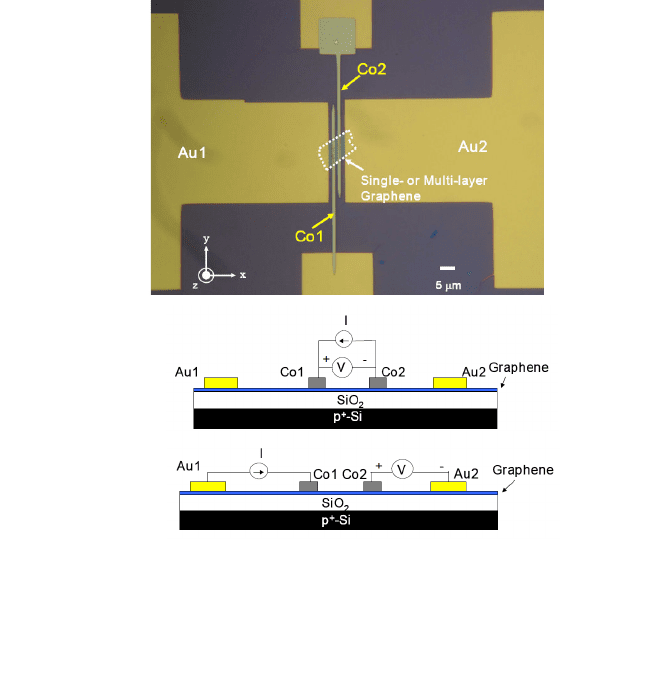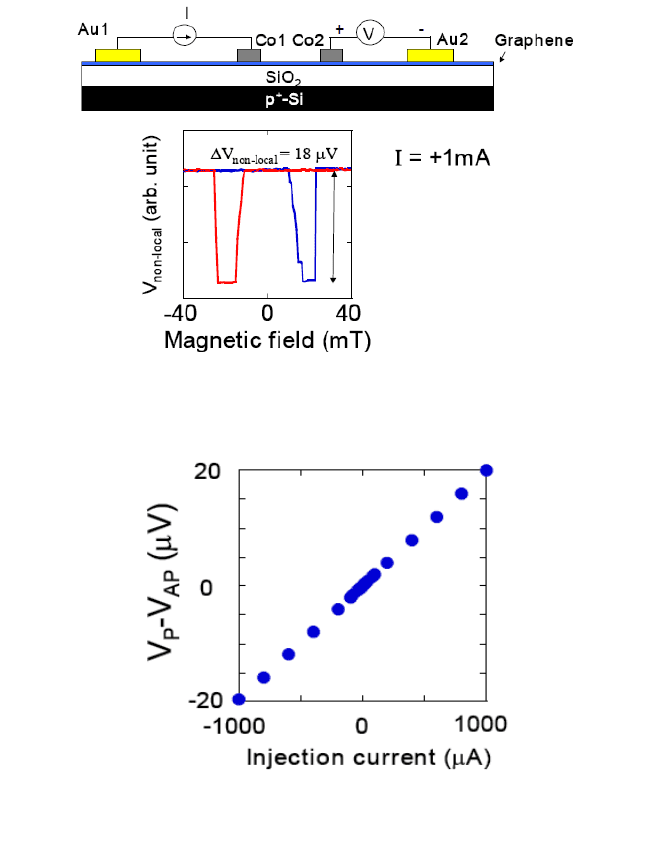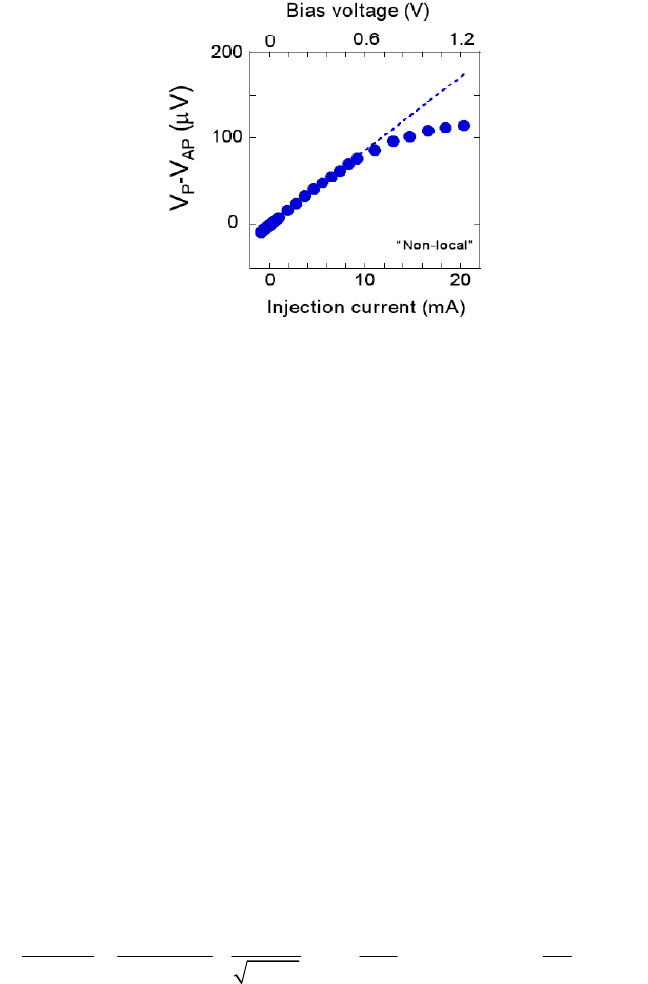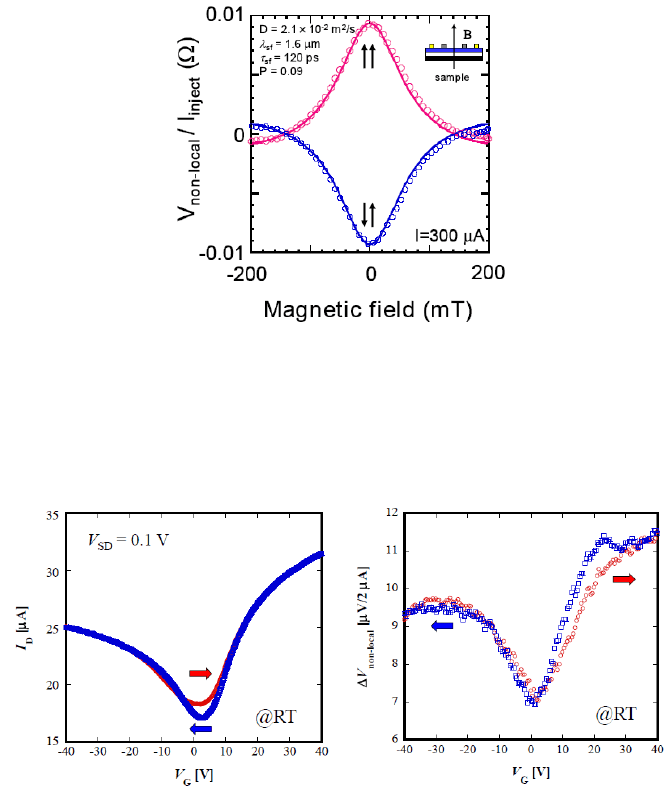Pati S.K., Enoki T., Rao C.N. R. (eds.) Graphene and Its Fascinating Attributes
Подождите немного. Документ загружается.

215
Chapter 14
Spin Transport in Single- and Multi-Layer Graphene
M. Shiraishi,
*
M. Ohishi, N. Mitoma, T. Takano, K. Muramoto,
R. Nouchi, T. Nozaki, T. Shinjo and Y. Suzuki
Graduate School of Engineering Science, Osaka Univ.,
Machikaneyama-cho 1-3, Toyonaka 560-8531, Osaka, Japan
*
PRESTO-JST, 4-1-8 Honcho, Kawaguchi 332-0012, Saitama, Japan
*
shiraishi@mp.es.osaka-u.ac.jp
Spin transport in molecular systems has been attracting much attention, because
a weak spin-orbit interaction in molecules allows us to expect good spin
coherence. Although spin injection and spin transport in molecules were not
easily achieved at room temperature, graphene, which is one of the most
attractive materials in condensed matter physics since 2004, provided an ideal
platform to realize and discuss spin injection and transport at room
temperature. We present our study on spin injection into graphene and
important findings of unique spin transport properties in graphene.
1. Introduction
After the first success of fabricating multi-layer graphene and its field
effect transistors (FETs) in 2004 [1], a tremendous number of studies has
been implemented in order to clarify attractive physical features of single-
layer and multi-layer graphene (SLG and MLG) [2-9], which induces much
interest for graphene electronics.
In 2007, introduction of a spin degree freedom to graphene
electronics, namely, establishing a field of graphene spintronics, was
successfully achieved by several groups, including our group, individually
[10-12], where spins were injected, a pure spin current was generated and
the spins were manipulated in SLG and MLG up to room temperature (RT).
The reason why people are attracted by spin injection into carbonaceous
216 M. Shiraishi et al.
molecules is based on facts that the low atomic mass of carbon can induce
the weak spin-orbit interaction and that 99% of the carbon isotopes has no
nuclear spin and therefore hyperfine interaction between nuclei and
electronic spins should be weak.
Our group has vigorously investigated spin transport properties in
SLG and MLG in recent several years [10, 13-16]. In this manuscript, we
will describe how to generate a pure spin current in graphene and the detail
of the non-local spin transport, which enables us possible to exclude
spurious signals. Next, we will describe unprecedented robustness of spin
polarization in MLG spin valves at room temperature. Surprisingly, the spin
polarization of injected spins was constant up to a bias voltage of +2.7 V
and -0.6 V in positive and negative bias voltage applications at room
temperature, which is superior to all spintronics devices. Our finding is
induced by suppression of spin scattering due to an ideal interface formation.
[13, 14]. In addition, spin transport and gate-induced modulation of a pure
spin current in SLG, as theory predicts, will be described [15].
2. Experimental
The starting materials used for preparation of the SLG and MLG spin
valves were highly oriented pyrolytic graphite (HOPG, NT-MDT Co.) and
polyimide-oriented highly oriented graphite (Super graphite, Kaneka Co.)
[17]. Graphene flakes were peeled from these materials using adhesive tape.
The flakes were then pushed onto the surface of a SiO
2
/Si substrate (SiO
2
thickness = 300 nm). The typical thickness of the MLG that provided
observable spin injection signals in a spin valve structure was 2-40 nm. In
the case of the SLG spin valves, we have verified that the layer number was
one by using Raman spectroscopy. The non-magnetic and ferromagnetic
electrodes used were Au/Cr (=40/5 nm) and Co (=50 nm), respectively, and
were patterned using an electron beam lithography technique. The width of
the Co electrodes, Co1 and Co2, were the same, but Co2 possessed a pad
structure in order to weaken the coercive force, and the typical gap width of
the Co electrodes was 1.5 µm (see Fig. 1(a)).
All measurements of MR effects were performed at RT. We
introduced a non-local scheme [18] in addition to a conventional local

Spin Transport in Single- and Multi-Layer Graphene 217
scheme for excluding spurious signals (see Figs. 1(b) and (c)). One can
detect a non-local output voltage which is induced by position dependence
of electrochemical potential of the generated spin current in the graphene.
Here, spins are injected at ferromagnet(FM)/graphene of the top layer of the
graphene in the injector side (between Co1 and Au1) as an electric current
and accumulated spins diffuse from Co1 to Co2 and Au2 (the detector side).
Hence, an output voltage induced by the generated spin current is
determined by an amount of accumulated spins, namely, it is strongly
affected by the interface spin polarization at Co1/graphene. In a non-local
scheme, an electric current I is injected from Co1 into GTF and extracted at
Au1. The voltage difference is measured between Co2 and Au2. The
Fig. 1. A microscopic image of a graphene spin valve (top), and a non-
local measurement
scheme (middle) and a local measurement scheme (bottom) for spin injection into SLG
and MLG.

218 M. Shiraishi et al.
non-local voltage, V
non-local
, is defined as (V
+
- V
-
). In a local scheme, an
electric current I is injected from Co1 into GTF and extracted at Co2. The
voltage difference is measured also between Co1 and Co2. The “local”
voltage, V
local
, is defined as (V
+
- V
-
). The spin injection was investigated
using a four terminal probe system (ST-500, Janis Research Company Inc.)
with an electromagnet. The magnetic field was swept from -400 Oe to +400
Oe in steps of 8 Oe. A source-meter (Keithley Instruments Inc., KH2400)
and a multi-meter (Keithley Instruments Inc., KH2010) were used to detect
spin injection signals. The Hanle effect was investigated using a physical
property measurement system (PPMS, Quantum Design Inc.) at RT. The
magnetic field was swept from -200 mT to +200 mT in ca. 3 mT steps. The
initial magnetization configuration of Co1 and Co2 was set to be either
parallel or anti-parallel.
3. Results and Discussion
Figure 2 shows a typical spin injection signal in graphene at RT in a non-
local measurement scheme, where an injection electric current was set to be
+1 mA, and clear hysteresis of non-local spin voltage is observed. Here, it
should be noted that anisotropic MR (AMR) signals, as observed in a local
measurement scheme (not shown here, and see ref. [13]) were not observed
in this measurement, which unambiguously indicates that the non-local
measurement can exclude spurious signals in spin injection measurements,
such as AMR signals, and allows us to detect only reliable spin injection
signals. When we have changed the injection electric current from +1 mA to
-1 mA in an MLG spin valve, linear dependence of the spin voltages was
seen as shown in Fig. 3. We have verified that the same linear dependence
was also observed even when we introduced the local measurement scheme
[13]. When we assume that all contact resistances have same values for
simplicity, the non-local output voltage to be expressed as the following
generalized form [19],
2
1
-
2 2
2
( ) [sinh( )] ,
(1 )
F
non local F inject
N sf
P R L
V R I
R
P
λ
−
∆ = ⋅ ⋅
−
(1)

Spin Transport in Single- and Multi-Layer Graphene 219
Fig. 2. A typical non-
local spin injection signal observed in the graphene spin valves at
RT.
Fig. 3.
The observed linear dependence of the spin voltage for the injection electric
current in the MLG spin-valves.
where P is the spin polarization,
λ
sf
is the spin flip length, L is the gap length
between two FM electrodes, I
inject
is the injected electric current, R
F
and
R
N
are spin accumulation resistances of FM and NM, respectively, which
is defined as (the conductivity) × (the spin diffusion length)/(the cross-
sectional area). From Eq. (1), it is interpreted that the linear dependence is
220 M. Shiraishi et al.
induced by constant spin polarization, and this finding manifested the
robustness of the spin polarization at Co/MLG within ±1 mA. It is widely
known that MR ratio in tunnel magnetoresistance (TMR) devices
monotonously decreases as bias voltage increases, which is thought to be
attributed to decrease of spin polarization of injected spins due to
magnon/phonon excitations and the spin signals was a half of the maximum
at +1 V at RT [18]. Such decrease of spin polarization can be an obstacle for
practical applications for MRAM and so on, and much effort has been paid
for overcoming the problem. In the case of graphene, such decrease could be
also a major problem if spin transistor will be fabricated. Here, the sample
resistance was ~200 Ω, in which the resistance of one Co electrode wire and
the MLG was measured to be ~50 Ω and ~5 Ω, respectively. This indicates
that additional resistance (~50 Ω each) exists at a Co/graphene interface
although no tunneling barrier such as Al-O was introduced. As a result, the
spin polarization (=MR ratio) of this sample was constant up to ~100 mV at
RT, which is surprising compared with the results of other spin valves,
where no such robustness was observed. In order to determine the maximum
voltage where the spin polarization is constant, another MLG device
(R
Au-Co
~109 Ω) was prepared and investigated using the non-local method,
where the sample resistance without the Co wire resistance was ~60 Ω.
Although the electrode (not the MLG channel) was broken at 20.3 mA, the
current dependence of the output voltage exhibited very unique behavior,
namely, the output voltage exhibited the linear dependence (robustness of
the spin polarization) until 0.5 V; above 0.5 V, it exhibited sub-linear
dependence. However, even at ~1.2 V, the spin polarization was still 81% of
the initial value (Fig. 4). In addition, further experiments using the other
samples exhibited that the robustness was maintained up to +2.7 V under a
positive bias voltage application and down to -0.6 V under a negative
voltage application (see ref. [13]). More importantly, the robustness was
detected even in a SLG spin valves, where the spin polarization of the
injected spins was constant up to + 1 V whereas it exhibited deviation from
the linear dependence of the spin voltages and no linear dependence in the
negatively biased condition [15]. Although the investigation was not carried
out in detail, it is notable that the similar asymmetry of spin voltages in
positively and negatively biased conditions has been reported by Kawakami
and co-workers in SLG when a spin carrier was hole [21]. Further study

Spin Transport in Single- and Multi-Layer Graphene 221
Fig. 4. The observed better robustness.
should be needed, but we believe that the asymmetry is probably ascribed to
a difference of spin propagation directions (spin injection from ferromagnet
to nonmagnet or spin extraction from nonmagnet to ferromagnet) as
observed in CoFe/AlO/Al spin devices [22]. Interestingly, the similar
robustness of spin polarization of injected spins in nonmagnetic channels
was recently observed in Si spin valves by using a non-local technique [23],
and hence the robustness may be an essential nature of group-IV elements
(carbon and silicon).
Next, Hanle-type spin precession experiments were implemented in
order to verify that the obtained signals are ascribed to spin injection into the
MLG. (see Fig. 5). For this purpose, we applied a magnetic field in the y
direction in order to prepare the Co electrodes in a parallel or anti-parallel
magnetization direction, and the field was then removed and a magnetic
field, B, was scanned in the z direction (see Fig. 1). The clear crossing of
parallel and anti-parallel signals was observed at +170 and -170 mT, which
directly indicates that the observed signals were attributed to the spin
injection into the MLG. By using the following equation for spin precession
[18],
2 2
-
0
1
exp( )cos( )exp( ) ,
/ 4
4
non local
L
inject MLG sf
V P L t
t dt
I A D Dt
Dt
ω
σ τ
π
∞
= − −
∫
(2)

222 M. Shiraishi et al.
Fig. 5. Modulation of the non-
local resistance due to spin precession, as a function of
perpendicular magnetic field. The injection current was set at 300 µ
A. The red (parallel,
↑↑) and blue (anti-parallel, ↓↑
) open circles are experimental data, and the red and blue
lines are the result of model fitting.
Fig. 6. (Left) A typical FET characteristics of a SLG spin FET at RT. Arrows
indicate
the directions of the gate-voltage sweep. (Right) Gate-
voltage dependence of the
corresponding spin voltages in the SLG spin FET. Arrows indicate the directions of the
gate-voltage sweep. The spin voltages were detected by using a non-local techn
ique.
The signal is the minimum where the conductivity of the SLG is the minimum (the Dirac
point), which directly means that the contact is electrically transparent as we have
designed.

Spin Transport in Single- and Multi-Layer Graphene 223
where t is time,
τ
sf
is the spin coherent time and D is a diffusion constant, the
spin diffusion constant D (=2.1 × 10
-2
m
2
/s), spin flip length
λ
sf
(=1.6 µm),
spin coherent time
τ
sf
(=120 ps), and spin polarization P (=0.09) was
estimated, although it should be noted that this is an approximate estimation
because the Eq. (2) is the only existing expression for the estimation of spin
transport properties in the case of the Hanle type spin precession. The
observed spin coherence is almost same as that reported in SLG [11], and
how to enhance the coherence is the next important milestone.
Finally, a prototypical graphene spin transistor operation using SLG is
introduced. So far, there were several reports on gate-voltage-induced
modulation of spin voltages in SLG spin valves [11, 12]. According to a
theory [19], non-local spin voltage exhibits the following relationships with
conductivity of a nonmagnetic channel as the contact between ferro- and
non- magnets changes:
for an Ohmic contact,
2
1
-
2 2
2
( ) [sinh( )] ,
(1 )
F
non local F inject
N sf
P R L
V R I
R
P
λ
−
∆ = ⋅ ⋅
−
(~
σ
N
) (3)
for a tunneling contact
2
-
1
exp( ).
2
sf
non local
N sf
P
V L
R
I A
λ
σ λ
∆
= ∆ = − (4)
When we look back a previous study [11], the gate-voltage dependence of
the spin voltage in SLG spin valves with Al-O tunneling barriers exhibited
an opposite dependence as the theory predicts, namely, the spin voltage was
the smallest at the Dirac point where the conductivity of the SLG was the
minimum although the Al-O tunneling barrier was inserted between Co and
SLG. In the other study, the spin voltage had no obvious gate voltage
dependence. In this sense, it can be said that there is much room for
investigation of gate-voltage dependence of spin signals in SLG spin valves.
We have designed our SLG spin valves as they have no tunneling barriers,
and examined whether the spin voltages are proportional or inversely
proportional. Figure 6 (Left) shows the FET characteristics of our SLG, and
the Dirac point was at the gate voltage of ~5 V. The suppression of the
